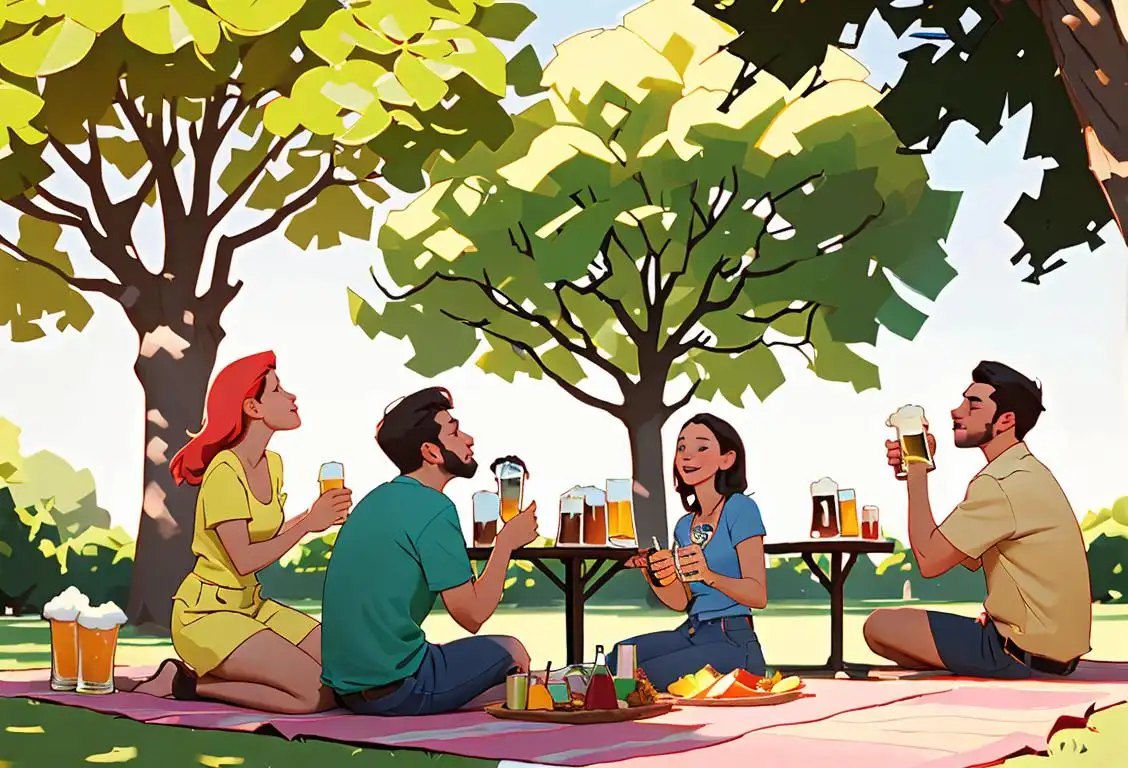National Left Overs Day

Welcome to National Leftovers Day, a day dedicated to embracing those delicious remnants of yesterday's feast! Whether you're a master at repurposing leftovers or you have a tendency to forget about them in the back of the fridge, this is the perfect day to celebrate the art of culinary recycling. So grab your Tupperware, put on your creative chef hat, and let's dive into the world of leftovers!
When is Left Overs Day?
It's national left overs day on the 5th July.
The Origins of National Leftovers Day
Leftovers have been a culinary phenomenon for as long as humans have been cooking food. We've all experienced those moments when we cook a little too much and are left with a surplus of food. But it wasn't until the dawn of the internet that National Leftovers Day gained recognition.
The earliest mentions of National Leftovers Day can be traced back to July 5, 2015. It seems that in the era of social media, people started openly sharing their love for leftovers, sparking a nationwide celebration. Word spread quickly, and now, every year on this day, we embrace the beauty of those forgotten remnants that lurk in our refrigerators.
How to Celebrate National Leftovers Day
Celebrating National Leftovers Day is as easy as reheating yesterday's dinner! Here are some suggestions for embracing this day to the fullest:
- Host a leftovers potluck: Invite your loved ones to bring their own leftovers and share in the feast. It's a perfect way to try new flavor combinations!
- Get creative: Challenge yourself to come up with innovative dishes using your leftovers. Turn that roast chicken into a mouthwatering sandwich or transform those mashed potatoes into crispy potato pancakes.
- Donate to a food bank: Leftovers don't always have to be for personal consumption. Give back to your community by donating unused, unspoiled leftovers to a local food bank.
Did You Know?
Did you know that the most common leftover in American households is pizza? Whether enjoyed cold or reheated, pizza remains a beloved leftover, and some may argue that it tastes even better the next day. So next time you have leftover pizza, know that you're part of a time-honored tradition!
History behind the term 'Left Overs'
1914
The Rise of the Tin Can
In the early 1900s, the popularity of canned food began to skyrocket. With the advent of industrial canning, people had the ability to preserve food for longer periods of time. This led to an increase in the availability and variety of canned goods in households, including fruits, vegetables, and meats.
1851
The Origins of 'Left Overs'
The term 'left overs' originated in the year 1851. It was initially used to describe the remaining food from a previous meal that was set aside to be eaten later. This concept of saving food and reusing it later was driven by frugality and resourcefulness, as people wanted to avoid wasting any edible portions. The term 'left overs' quickly became popular as a way to refer to these saved food items.
1790
The First Mention of 'Leftovers'
The term 'leftovers' was first mentioned in 1790 in an English book titled 'The Cook's Oracle' by William Kitchiner. Kitchiner used the term to refer to 'bits and scraps' leftover after a meal. This marked the earliest recorded use of the term in print.
1811
Expanding Definition
In 1811, 'leftovers' began to take on a broader definition, encompassing not only the remnants of a meal but also any unused or remaining items. This expanded definition allowed the term to be used in a variety of contexts, from culinary to non-food related scenarios.
1920
The Practice of Saving
During the 1920s, there was a cultural shift towards frugality and resourcefulness. As a result, people started to embrace the idea of not letting any food go to waste. This led to a habit of saving uneaten portions of meals for later consumption.
1920s
Cultural Integration and Left Overs
During the 1920s, cultural integration played a significant role in shaping the concept of 'left overs.' As different ethnic groups migrated and settled in various regions, they brought their own culinary traditions and practices. The term 'left overs' gained new flavors and recipes as people incorporated diverse cuisines and cooking styles into their meals. Left overs became a way to explore a fusion of flavors and experiment with new dishes.
1843
Leftovers as a Frugal Solution
By the mid-19th century, 'leftovers' gained recognition as a frugal solution to reduce waste and make use of excess food. The concept resonated with a society increasingly concerned with resourcefulness and economy. Leftovers became associated with practicality and thriftiness.
1950s
Convenience and the Rise of Left Overs
In the 1950s, as technology advanced and modern conveniences became more accessible, the concept of 'left overs' gained further popularity. The rise of refrigerators, Tupperware, and other storage containers made it easier for people to preserve and store food for longer periods. This, in turn, led to an increase in the practice of intentionally cooking larger quantities to have 'left overs' for later consumption. It became a convenient way to save time in meal preparation and reduce food waste.
1937
The Term 'Left Overs' Emerges
While the practice of saving remaining food had been around for some time, it wasn't until 1937 that the term 'left overs' gained popularity. It was derived from the notion of food left over from a previous meal. This phrase quickly caught on and became part of everyday language.
1970s
Sustainability and Left Overs
By the 1970s, the importance of reducing food waste and promoting sustainability became more prevalent. The term 'left overs' took on an additional significance as it aligned with the principles of conservation and environmental consciousness. Using 'left overs' to create new meals or repurpose them in innovative ways became a means to reduce food waste and make more sustainable choices. This shift in perspective elevated the term beyond its original frugal roots.
1890
Leftovers in American Cuisine
During the late 19th century, leftovers became more prominent in American cuisine. As households expanded and food preservation methods improved, leftovers became a common part of meal planning. This cultural shift led to the creation of new recipes specifically designed to repurpose leftovers.
1950
Convenience and Microwave Revolution
As technology advanced, the 1950s saw the rise of convenient appliances, most notably the microwave oven. With the ability to quickly and easily reheat food, the consumption of leftovers became even more prevalent. Leftovers provided a quick and easy meal option for busy households.
1940s
World War II Influence
The scarcity of resources during World War II further emphasized the importance of utilizing leftovers. Rationing and food shortages encouraged people to be more creative with their cooking and find innovative ways to stretch meals. This era cemented the notion that leftovers were a practical and patriotic approach to food consumption.
Present
Creative Culinary Adventures with Left Overs
In the present day, the term 'left overs' has evolved to represent a world of culinary possibilities. Chefs and home cooks view 'left overs' as opportunities to create exciting and unique dishes. The practice of transforming 'left overs' into gourmet meals showcases culinary skills and imagination. It has become a symbol of creativity in the kitchen, inspiring individuals to think outside the box and experiment with flavors and textures. 'Left overs' are no longer just saved food; they are an avenue for culinary adventures.
1970
Creative Leftover Recipes
During the 1970s, the practice of repurposing leftovers gained traction. Creative cooks began exploring ways to transform leftover dishes into new and exciting meals. This led to the creation of various leftover recipe ideas, such as casseroles, soups, and stir-fries.
1960s
Convenience Culture and 'TV Dinners'
The rise of convenience culture in the 1960s brought pre-packaged and frozen meals into the mainstream. 'TV dinners' became popular, providing quick and easy solutions for busy households. Leftovers played a role in this cultural shift as well, as they often served as the inspiration for these frozen meal options.
Present
A Sustainable Solution
Today, the term 'left overs' has become ingrained in our culinary culture. It serves as a reminder of the importance of reducing food waste and finding innovative ways to utilize every bit of food. Leftovers have evolved from being a mere afterthought to a delicious and sustainable solution for meals.
Present
Continued Relevance and Culinary Creativity
Today, leftovers remain a practical and eco-friendly approach to food management. With an increased focus on reducing food waste, many individuals and restaurants actively seek ways to repurpose leftovers into new and exciting dishes. Leftovers are no longer seen as simply remnants; they're a canvas for culinary creativity and a way to enjoy reimagined meals.
Did you know?
The most common leftover in American households is pizza.Tagged
food fun loved onesFirst identified
5th July 2015Most mentioned on
5th July 2015Total mentions
8Other days
Biscuit Day
Cheese Lovers Day
Cheese Pizza Day
Agriculture Day
Bacon Day
Medal Of Honor Day
Pumpkin Day
Foundation Day
Guac Day
Drink A Beer Day









